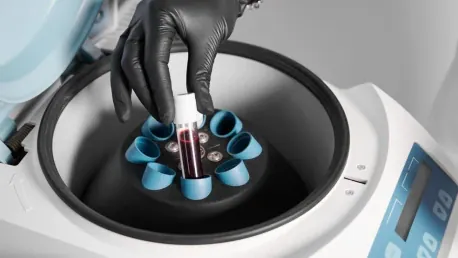The Global Plasma Protein Therapeutics Market is on a significant growth trajectory, projected to reach approximately USD 40 billion by 2030. This expansion is driven by the indispensable role that plasma protein therapies play in treating a wide array of medical conditions, such as hemophilia, multiple sclerosis, and immune thrombocytopenia. These therapies, derived from human plasma, are vital for supplying essential clotting factors, regulating immune functions, and significantly improving patient outcomes.
Plasma Protein Therapeutics: An Overview
The Importance of Plasma Proteins
Plasma protein therapeutics are treatments that involve proteins extracted from human plasma—the liquid component of blood that contains crucial proteins like albumin, immunoglobulins, and clotting factors. These therapies are critical for maintaining immune function, regulating blood clotting, and managing several vital physiological processes. They are used to treat a variety of conditions, including immune deficiencies, hemophilia, and certain autoimmune disorders. By isolating and purifying specific proteins from plasma, these treatments can replace missing or deficient proteins in patients, thereby offering life-saving interventions for chronic and rare diseases.
Beyond their fundamental role in addressing acute medical conditions, plasma protein therapies also contribute significantly to the quality of life for chronic illness sufferers. Patients with ongoing immune deficiencies or recurrent clotting disorders rely heavily on these treatments to maintain normalcy in their daily lives. The precise formulation and administration of these therapies allow for personalized treatment plans, catering to the unique needs of individual patients. The multifaceted applications of plasma proteins underscore their importance in modern medicine, enhancing patient care and recovery rates across numerous clinical scenarios.
The Manufacturing Process
The manufacturing process of plasma protein therapeutics is complex and involves meticulous screening, fractionation, and purification steps to ensure both safety and efficacy. Donated plasma undergoes extensive testing to eliminate the risks of infectious diseases, and the therapies themselves are subject to stringent regulatory oversight. Unlike synthetic drugs, plasma protein therapies require human donors, making the availability of these treatments reliant on voluntary plasma donations. While advancements in biotechnology are leading to the development of recombinant alternatives, plasma-derived products continue to be crucial for conditions where synthetic proteins have not yet matched their therapeutic benefits.
The fractionation process involves separating the different proteins found in plasma, each of which can be utilized to treat specific conditions. For example, immunoglobulins are essential for combating infections in immune-compromised patients, while albumin is often used in critical care settings to manage blood volume and pressure. Stringent purification processes are vital to remove any contaminants and ensure that the final product is safe for patient use. Regulatory agencies, such as the FDA, closely monitor these steps, requiring comprehensive documentation and adherence to rigorous quality standards. The reliance on human donors and the intricate manufacturing processes highlight the challenges and resource demands associated with producing these essential therapies.
Market Dynamics and Segmentation
Rising Demand and Prevalence of Conditions
The demand for plasma protein therapeutics is bolstered by their effectiveness in treating a broader spectrum of rare and chronic diseases. This demand has been further amplified by the rising prevalence of conditions such as hemophilia and immune deficiencies, and an increase in diagnosis rates helps identify more cases worldwide, thereby driving the need for such therapies. Growing awareness of these conditions and the available treatment options is contributing to the market’s growth in both developed and emerging economies.
Additionally, the aging global population is experiencing a higher incidence of chronic diseases that require long-term management through plasma protein therapies. This demographic shift is creating an upward trajectory in the market as older adults are at a greater risk of conditions that impair immune function and blood clotting. Moreover, as healthcare systems in developing nations improve and diagnostic capabilities expand, the detection of previously underdiagnosed conditions is on the rise, further pushing the demand for plasma-derived treatments. Public health initiatives and educational campaigns are also playing a significant role in enhancing the understanding of these therapies, encouraging patients to seek early diagnosis and treatment.
Product Segmentation
The plasma protein therapeutics market is highly segmented based on product types and applications. Key product segments include immunoglobulin, albumin, plasma-derived Factor VIII, and others. These products have varying applications, notably in treating conditions like hemophilia, idiopathic thrombocytopenic purpura, primary immunodeficiencies, and other related disorders.
Immunoglobulins are widely used to treat immune deficiencies and autoimmune diseases, providing critical support to the body’s defense mechanisms. Albumin is primarily utilized in treating blood volume loss in critical care settings and managing liver diseases. Plasma-derived Factor VIII is essential for individuals with hemophilia A, helping them manage bleeding episodes effectively. Other plasma-derived therapies address a range of medical conditions, including neurological disorders, pulmonary diseases, and even some forms of cancer. The diversification of these products helps meet the unique needs of different patient populations, ensuring that plasma protein therapies can cater to a wide array of medical requirements.
Geographic and Competitive Landscape
North America’s Dominance
North America dominated the plasma protein therapeutics market in 2023 and is expected to maintain its dominance throughout the forecast period. This robust growth is largely attributed to the high prevalence of conditions such as Guillain-Barré Syndrome and an increasing demand for effective treatments in the region. Additionally, continuous developments and approvals of new plasma protein therapies are expected to significantly boost the North American market from 2024 to 2030.
The extensive healthcare infrastructure and significant investments in research and development in North America are crucial factors driving this dominance. The region’s ability to implement advanced technologies and maintain stringent regulatory frameworks ensures the high quality and safety of plasma protein therapeutics. Furthermore, the presence of leading pharmaceutical companies and research institutions fosters an environment conducive to innovation and continuous improvement in treatment modalities. As regulatory bodies continue to approve new plasma-based treatments and expand the indications for existing ones, North America is likely to see sustained growth in this market segment.
Strategic Collaborations and Regulatory Support
Strategic collaborations between biotech companies, pharmaceutical firms, and research institutions in North America are set to further propel market expansion. For instance, in September 2022, Grifols entered into a landmark long-term agreement with Canadian Blood Services to enhance Canada’s self-sufficiency in immunoglobulin (Ig) therapies. Such collaborations are crucial for securing a steady supply of plasma protein therapies.
Regulatory bodies like the U.S. FDA are actively working to facilitate the development and accessibility of these treatments, providing swift approvals and guidance for innovative therapies. Collaborative efforts, such as those between Kedrion Biopharma and Kamada Ltd., which led to the FDA approval for a label update of KEDRAB® (Rabies Immune Globulin [Human]), exemplify the impact of regulatory support in advancing the industry. These partnerships and regulatory endorsements are instrumental in ensuring that a broader patient population can benefit from these life-saving therapies, while also maintaining the highest safety and efficacy standards. The alignment of regulatory frameworks with industry capabilities is a critical driver of growth in the plasma protein therapeutics market.
Key Trends and Developments
Technological Advancements
Technological advancements and therapeutic innovations are leading the change in the plasma protein therapeutics landscape. Developments in biotechnology are enabling the creation of next-generation plasma-based therapies, which are more effective and safer. Enhanced purification technologies and screening processes have also improved the safety profile of plasma-derived products, boosting their market acceptance.
Innovative manufacturing techniques, such as advanced chromatographic processes and state-of-the-art fractionation methods, have significantly improved the yield and purity of plasma-derived proteins. These techniques help reduce the risk of contamination and lower the incidence of adverse reactions in patients. Furthermore, the integration of artificial intelligence and machine learning in the plasma protein manufacturing process is streamlining quality control procedures and expediting the development of new therapies. These technological advancements not only enhance the efficacy and safety of plasma protein therapeutics but also make them more accessible to patients worldwide by optimizing production efficiencies.
Innovations in Plasma Proteomics
In March 2024, Biognosys announced the release of enhanced plasma proteomics workflows for its TrueDiscovery® unbiased discovery proteomics research services platform. These new workflows utilize an innovative plasma enrichment method, providing comprehensive proteome coverage with outstanding data quality, reproducibility, and efficiency. Such innovations are pivotal in advancing the field and enhancing the effectiveness of plasma protein therapeutics.
The advancements in plasma proteomics are facilitating deeper insights into the human proteome, enabling the identification of novel biomarkers and therapeutic targets. This innovation is especially significant for personalized medicine, as it allows for the customization of treatments based on individual patient proteomic profiles. The improved workflows and enhanced data quality from these innovations are accelerating the discovery and development of new plasma protein therapies, thus expanding their therapeutic potential. The continuous evolution of plasma proteomics is ensuring that the therapeutic applications of plasma proteins are both broadening and becoming more precise, resulting in better clinical outcomes for patients.
Challenges and Market Barriers
Reliance on Plasma Donation
The plasma protein therapeutics market is not without its challenges. Chief among these is the reliance on plasma donation, which is resource-intensive and requires substantial infrastructure and logistic support. Fluctuations in donor availability, coupled with stringent regulatory guidelines, can impact the supply chain and the availability of therapies. To mitigate these risks, companies are focusing on expanding their plasma collection networks, especially in regions with untapped donor potential.
To bolster plasma collection, many companies have started implementing incentive programs and awareness campaigns to attract more donors. They are also investing in mobile collection units and establishing new donation centers in strategic locations. However, the reliance on human donors inherently limits the scalability of plasma-derived therapies, making it imperative to maintain a robust and efficient donor network. Organizations are also exploring the potential of synthetic plasma proteins through recombinant technology to reduce this dependency. Despite these efforts, the fundamental need for plasma donations remains a significant challenge that the industry must continually address to ensure a consistent supply of life-saving therapies.
Regulatory and Pricing Pressures
Regulatory frameworks and pricing pressures further shape the market dynamics. Regulatory agencies enforce strict guidelines on plasma collection, manufacturing, and distribution, ensuring the safety of patients. However, the high costs associated with plasma protein therapies and their complex production processes often result in higher pricing, which can limit access, especially in low-income regions. Efforts to improve production cost-efficiencies and initiatives aimed at enhancing healthcare accessibility are key to overcoming these hurdles and supporting market growth.
Healthcare providers and policymakers are working together to develop pricing strategies that broaden patient access while maintaining industry sustainability. Innovative reimbursement models and government-funded programs are being considered to alleviate some of the financial burdens on patients and healthcare systems. Additionally, ongoing research into improving the cost-effectiveness of the manufacturing process may help reduce overall therapy costs. Despite these efforts, balancing the high costs of producing plasma protein therapeutics with the need for affordable patient access remains a complex issue that the industry must navigate carefully.
Future Outlook and Market Projections
The future of the plasma protein therapeutics market looks promising, with a projected CAGR of around 7% from 2021 to 2030, resulting in a market size of approximately USD 40 billion by 2030. The continuous increase in the prevalence of target diseases, coupled with advancements in therapeutic and biotechnological innovations, will continue to drive market growth.
North America’s leading position in the global market is expected to persist, supported by strategic collaborations, regulatory approvals, and product innovations. Additionally, emerging markets in Asia-Pacific and other regions are likely to contribute significantly to the growth due to increasing healthcare investments and rising awareness about plasma protein therapeutics.
Overall, the global plasma protein therapeutics market is on a solid growth path, driven by the essential nature of these therapies, continuous innovation, strategic collaborations, and regulatory support. The market dynamics, though influenced by challenges such as supply chain dependencies and pricing pressures, are being positively shaped by technological advancements and efforts to enhance healthcare accessibility globally.
Conclusion
The Global Plasma Protein Therapeutics Market is experiencing notable growth, with projections indicating it could reach around USD 40 billion by 2030. This surge is largely due to the crucial role plasma protein therapies play in managing a wide range of medical conditions, including hemophilia, multiple sclerosis, and immune thrombocytopenia.
Derived from human plasma, these therapies are instrumental in providing vital clotting factors necessary for blood coagulation, modulating immune system functions, and significantly enhancing patient outcomes. The importance of plasma protein therapies can’t be overstated as they contribute to life-saving treatments and improved quality of life for many patients.
Conditions like hemophilia, for instance, involve a deficiency in specific clotting factors, and plasma protein therapies can supply these missing components, reducing the risk of severe bleeding episodes. Similarly, in immune thrombocytopenia, where the body incorrectly targets platelets, these therapies help regulate the immune response, preventing harmful platelet destruction.
Furthermore, the treatment landscape for multiple sclerosis, a chronic disease affecting the central nervous system, has been transformed by plasma protein therapies. They help manage symptoms and slow disease progression, offering patients a chance at better long-term outcomes.
Overall, the increasing demand for these therapies highlights their indispensable nature in modern medicine and the ongoing advancements in the Global Plasma Protein Therapeutics Market.









